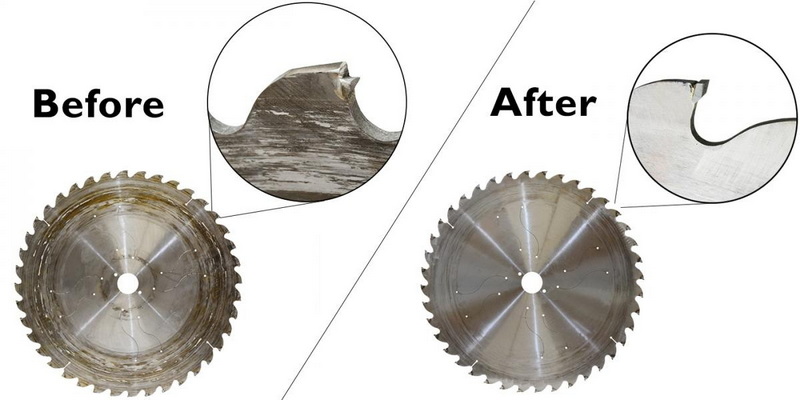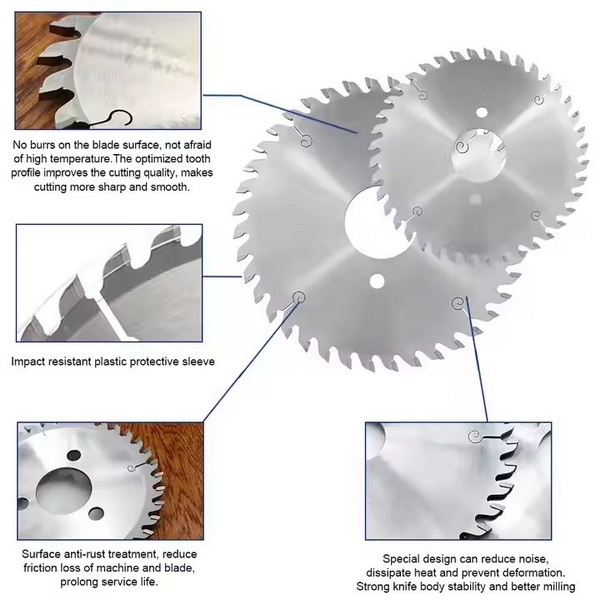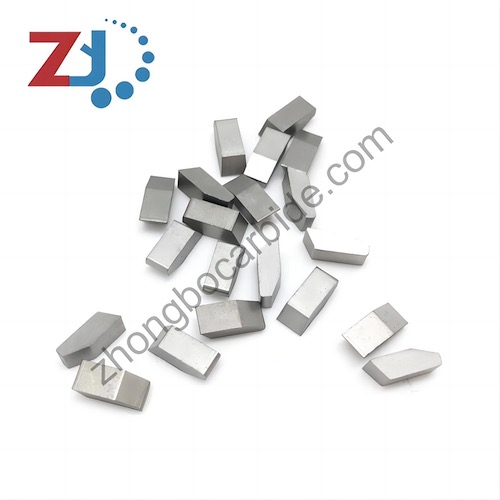Content Menu
● Why Sharpen Tungsten Carbide Blades?
● Methods for Sharpening Tungsten Carbide Blades
>> Diamond Grinding Wheels
>> Silicon Carbide Grinding Wheels
>> Electrical Discharge Machining (EDM)
>> Laser Sharpening
● Factors to Consider When Sharpening Tungsten Carbide Blades
● Common Mistakes to Avoid
● Step-by-Step Guide to Sharpening Tungsten Carbide Blades with a Diamond Grinding Wheel
>> Step 1: Preparation
>> Step 2: Setting Up the Grinding Wheel
>> Step 3: The Sharpening Process
>> Step 4: Finalizing and Inspection
● Alternative Sharpening Methods
>> Hand Sharpening with Diamond Lapping Pads
>> Professional Sharpening Services
● Maintaining Tungsten Carbide Blades
● Conclusion
● FAQ
>> 1. Can I sharpen tungsten carbide blades at home?
>> 2. What type of grinding wheel should I use for sharpening tungsten carbide blades?
>> 3. How often should I sharpen my tungsten carbide blades?
>> 4. What are the common mistakes to avoid when sharpening tungsten carbide blades?
>> 5. Is it worth it to sharpen tungsten carbide blades, or should I just replace them?
● Citations:
Tungsten carbide blades are prized for their exceptional hardness and durability, making them indispensable in industries demanding precision cutting[1]. These blades, while robust, inevitably lose their edge over time, necessitating sharpening to sustain peak performance[1]. The methods for sharpening tungsten carbide blades include diamond grinding wheels, silicon carbide wheels, electrical discharge machining (EDM), and laser sharpening[1]. Each technique offers unique advantages based on the precision needed and the blade type[1].

Why Sharpen Tungsten Carbide Blades?
Sharpening tungsten carbide blades is essential for several reasons:
- Maintaining Cutting Efficiency: A sharp blade cuts more cleanly and efficiently, reducing the effort required and improving the quality of the final product[1].
- Extending Blade Life: Regular sharpening prevents excessive wear and tear, prolonging the blade's lifespan and saving costs on frequent replacements[1].
- Ensuring Precision: Sharp blades provide greater control and accuracy, which is crucial in industries where precise cuts are necessary[1].
- Reducing Material Waste: Dull blades can cause splintering or rough cuts, leading to material waste. Sharpening ensures clean cuts and minimizes waste[1].
- Enhancing Safety: Sharp blades require less force to operate, reducing the risk of accidents and injuries[1].
Methods for Sharpening Tungsten Carbide Blades
Several methods can be employed to sharpen tungsten carbide blades, each with its own set of advantages and considerations[1].
Diamond Grinding Wheels
Diamond grinding wheels are the most effective method for sharpening tungsten carbide blades[1]. Diamond, being harder than tungsten carbide, can precisely grind and restore the blade's edge while causing minimal wear to the grinding tool[1].
Benefits:
- High Precision: Diamond grinding wheels offer excellent control, preserving the sharpness and angle of the blade's cutting edge[1].
- Durability: These wheels are highly durable and can withstand repeated use without significant wear[1].
- Efficiency: Sharpening with diamond grinding wheels is quick and effective, rapidly restoring the blade's sharpness[1].
How to Use:
1. Preparation: Ensure the blade is clean and securely mounted[1].
2. Angle Adjustment: Set the grinding wheel to the correct angle for the blade's cutting edge. Use a guide to maintain consistency[1].
3. Grinding: Apply consistent pressure while moving the blade across the diamond wheel[1].
4. Cooling: Use a coolant to prevent overheating, which can cause microcracks[1].
5. Inspection: Regularly check the blade's sharpness and angle to ensure optimal results[1].
Silicon Carbide Grinding Wheels
Silicon carbide grinding wheels are a more affordable alternative to diamond wheels[1]. While less effective for heavy-duty sharpening, they can still grind carbide blades[1]. However, this method may take longer and result in more wear on the grinding wheel[1].
Benefits:
- Cost-Effectiveness: Silicon carbide wheels are more budget-friendly than diamond wheels[1].
- Accessibility: They are widely available and suitable for lighter or occasional sharpening needs[1].
How to Use:
1. Preparation: Ensure the blade is clean and properly positioned[1].
2. Angle Adjustment: Set the wheel to the correct angle, using a guide for precision[1].
3. Grinding: Apply consistent pressure, moving the blade across the wheel[1].
4. Cooling: Use a coolant to minimize heat buildup[1].
5. Inspection: Regularly check the blade's sharpness and adjust as needed[1].
Electrical Discharge Machining (EDM)
Electrical Discharge Machining (EDM) is an advanced technique that uses electrical discharges to erode material from the blade's surface[1]. This method is known for its precision and ability to sharpen intricate and complex blade designs without applying mechanical force[1].
Benefits:
- High Precision: EDM is capable of extremely fine sharpening, ideal for blades with intricate geometries or tight tolerances[1].
- No Mechanical Stress: Unlike grinding, EDM does not apply physical force to the blade, reducing the risk of deformation or damage[1].
How to Use:
1. Setup: EDM machines require specialized technical setup[1].
2. Placement: The blade is placed in the machine[1].
3. Machining: Electrical discharges are used to precisely erode material from the blade's edge[1].
4. Monitoring: The process requires careful monitoring to ensure accuracy[1].
EDM is best suited for high-precision applications where maintaining the original geometry of the blade is critical[1].
Laser Sharpening
Laser sharpening is a modern, non-contact method that uses focused laser beams to sharpen tungsten carbide blades[1]. This process offers high accuracy and eliminates the risk of mechanical wear since the laser does not physically touch the blade[1].
Benefits:
- Extreme Precision: Laser sharpening can restore blades to their original sharpness with a high degree of accuracy, even for blades with complex edges[1].
- No Physical Wear: The absence of contact between the laser and the blade eliminates the risk of physical wear or damage[1].
- Speed: Laser sharpening can be faster than traditional grinding methods, making it suitable for high-production environments[1].
How to Use:
1. Setup: Laser sharpening requires advanced machinery and is typically performed in industrial settings[1].
2. Laser Application: A concentrated laser beam is directed at the blade's cutting edge[1].
3. Material Removal: The laser vaporizes small amounts of material to restore sharpness without applying any physical force[1].

Factors to Consider When Sharpening Tungsten Carbide Blades
Several factors must be considered to achieve the best results when sharpening tungsten carbide blades[1]:
- Cooling: Overheating is a significant risk. Use a coolant to maintain a safe temperature and prevent microcracks[1].
- Proper Angle: Maintaining the correct sharpening angle is crucial for achieving a sharp edge while preserving the blade's original geometry. Use a guide to ensure precision[1].
- Sharpening Frequency: Regular maintenance is key. Sharpen the blade before it becomes completely dull to maintain efficiency and reduce the need for frequent replacements[1].
- Quality of Sharpening Tools: Use high-quality diamond or silicon carbide grinding wheels for effective sharpening. The wrong abrasive can lead to poor results and potential damage[1].
Common Mistakes to Avoid
Sharpening tungsten carbide blades requires a careful approach. Here are some common mistakes to avoid[1]:
- Overheating the Blade: Excessive heat can cause microfractures or even break the tungsten carbide. Always use a coolant[1].
- Using Inappropriate Abrasives: Only use materials harder than tungsten carbide, such as diamond or silicon carbide. Softer abrasives will not sharpen the blade effectively[1].
- Incorrect Sharpening Angle: Applying the wrong angle can result in uneven wear and poor cutting performance. Use a sharpening guide to maintain consistency[1].
- Neglecting Regular Maintenance: Waiting too long to sharpen a blade can result in a longer sharpening process and decreased efficiency. Regular sharpening keeps blades in optimal condition[1].
Step-by-Step Guide to Sharpening Tungsten Carbide Blades with a Diamond Grinding Wheel
Sharpening tungsten carbide blades with a diamond grinding wheel is a precise process that requires attention to detail[1]. Here's a step-by-step guide to help you achieve optimal results:
Materials and Tools Needed:
- Tungsten carbide blade[1]
- Diamond grinding wheel[1]
- Coolant (water or oil-based)[1]
- Sharpening guide or jig[1]
- Safety glasses[1]
- Gloves[1]
- Cleaning brush[1]
- Soft cloth[1]
Step 1: Preparation
1. Clean the Blade: Use a cleaning brush to remove any debris, dirt, or residue from the blade. A clean blade ensures better contact with the grinding wheel[1].
2. Inspect the Blade: Check for any visible damage, such as chips, cracks, or warping. If the blade is severely damaged, it may need professional repair or replacement[1].
3. Safety Gear: Wear safety glasses and gloves to protect yourself from flying debris and sharp edges[1].
Step 2: Setting Up the Grinding Wheel
1. Mount the Diamond Grinding Wheel: Ensure the diamond grinding wheel is securely mounted on a stable grinding machine. Follow the manufacturer's instructions for proper installation[1].
2. Adjust the Angle: Use a sharpening guide or jig to set the correct angle for the blade's cutting edge. The angle is crucial for achieving a sharp and effective edge[1].
3. Position the Blade: Place the blade against the grinding wheel, ensuring it is aligned with the set angle[1].
Step 3: The Sharpening Process
1. Apply Coolant: Continuously apply coolant to the blade and grinding wheel to prevent overheating. Overheating can cause microcracks in the tungsten carbide, reducing its durability[1].
2. Grind the Blade:
- Apply consistent, light pressure as you move the blade across the diamond grinding wheel[1].
- Use smooth, even strokes to ensure uniform sharpening[1].
- Avoid applying too much pressure, as this can damage the blade or the grinding wheel[1].
3. Monitor the Progress:
- Regularly check the blade's edge to assess sharpness and angle[1].
- Use a magnifying glass to inspect for any imperfections[1].
4. Sharpen Both Sides: Ensure both sides of the blade are sharpened evenly to maintain balance and cutting efficiency[1].
Step 4: Finalizing and Inspection
1. Clean the Blade: After sharpening, thoroughly clean the blade to remove any grinding residue[1].
2. Inspect the Edge: Carefully inspect the sharpened edge for sharpness and consistency. If necessary, make minor adjustments[1].
3. Test the Blade: Perform a test cut on a scrap piece of material to ensure the blade cuts cleanly and efficiently[1].
Alternative Sharpening Methods
While diamond grinding wheels are the most common and effective method, other techniques can also be used to sharpen tungsten carbide blades[1].
Hand Sharpening with Diamond Lapping Pads
Hand sharpening with diamond lapping pads is a method suitable for touching up tungsten carbide blades, particularly for knives[4].
Materials Needed:
- Tungsten carbide blade[4]
- Diamond lapping pads (30 micron, 9 micron, and 3 micron)[4]
- Acrylic blank[4]
- Digital angle gauge[4]
- Zhuk fixed angle knife sharpener (or similar sharpening system)[4]
- Oil[4]
- Soft cloth[4]
Step-by-Step Guide:
1. Preparation:
- Clean the blade to remove any dirt or debris[4].
- Secure the blade in a fixed angle knife sharpener. Set the edge angle to 18 degrees per side (36 degrees total)[4].
2. Sharpening Process:
- Start with the 30-micron diamond lapping pad[4].
- Apply a thin layer of oil to the blade[4].
- Work both sides of the blade, maintaining consistent pressure and angle[4].
- Repeat the process with the 9-micron diamond lapping pad to refine the edge[4].
3. Polishing:
- Finish with the 3-micron diamond lapping pad to polish the edge[4].
- Ensure the blade remains oiled during this step[4].
4. Inspection and Testing:
- Clean the blade and inspect the edge for sharpness and consistency[4].
- Test the blade on a piece of material to ensure it cuts cleanly[4].
Professional Sharpening Services
For those who lack the equipment or expertise, professional sharpening services are a viable option[9].
Benefits:
- Expertise: Professionals have the knowledge and experience to sharpen blades correctly[9].
- Equipment: They use specialized equipment for precise and efficient sharpening[9].
- Convenience: Outsourcing the task saves time and effort[9].
Maintaining Tungsten Carbide Blades
Proper maintenance is crucial for prolonging the life and performance of tungsten carbide blades[1].
- Regular Cleaning: Clean the blade after each use to remove debris and prevent corrosion[1].
- Proper Storage: Store blades in a dry, secure place to protect them from damage[1].
- Avoid Overheating: Use appropriate cutting speeds and coolants to prevent overheating during use[1].
- Inspect Regularly: Check the blade for signs of wear or damage and address issues promptly[1].
Conclusion
Sharpening tungsten carbide blades is essential for maintaining their cutting efficiency, extending their lifespan, and ensuring precision in various industrial applications[1]. The most effective methods include using diamond grinding wheels, silicon carbide wheels, EDM, and laser sharpening[1]. Each method offers unique benefits, depending on the type of blade and the required precision[1]. Regular maintenance, proper sharpening techniques, and avoiding common mistakes are crucial for maximizing the performance and longevity of tungsten carbide blades[1]. Whether you choose to sharpen the blades yourself or opt for professional services, ensuring they are well-maintained will result in significant cost savings and improved productivity[1].

FAQ
1. Can I sharpen tungsten carbide blades at home?
Yes, it is possible to sharpen tungsten carbide blades at home using diamond grinding wheels or diamond lapping pads[1][4]. However, it requires careful technique, the right equipment, and attention to detail to avoid damaging the blade[1]. For those lacking experience or specialized equipment, professional sharpening services are a viable alternative[9].
2. What type of grinding wheel should I use for sharpening tungsten carbide blades?
The most effective type of grinding wheel for sharpening tungsten carbide blades is a diamond grinding wheel[1]. Diamond is harder than tungsten carbide and can precisely grind and restore the blade's edge with minimal wear to the grinding tool[1]. Silicon carbide grinding wheels are a lower-cost alternative but are less effective for regular, heavy-duty sharpening[1].
3. How often should I sharpen my tungsten carbide blades?
The frequency of sharpening depends on the usage and the material being cut[1]. Regular maintenance is key; don't wait until the blade becomes completely dull before sharpening[1]. Sharpening blades regularly keeps them in optimal condition, reduces wear, and maintains cutting efficiency[1]. Inspect the blade before each use and sharpen as soon as you notice a decline in cutting performance[1].
4. What are the common mistakes to avoid when sharpening tungsten carbide blades?
Common mistakes to avoid include overheating the blade, using inappropriate abrasives, applying the wrong sharpening angle, and neglecting regular maintenance[1]. Overheating can cause microfractures, so always use a coolant[1]. Only use materials harder than tungsten carbide, such as diamond or silicon carbide[1]. Use a sharpening guide to maintain the correct angle[1]. Regular sharpening prevents the need for more extensive and potentially damaging sharpening processes[1].
5. Is it worth it to sharpen tungsten carbide blades, or should I just replace them?
Sharpening tungsten carbide blades is generally worth it, as it extends the life of the blade and maintains its cutting efficiency[1]. A good quality carbide blade can be sharpened multiple times before needing replacement[9]. Sharpening is also more cost-effective than purchasing a new blade[9]. However, if the blade is severely damaged (warped, cracked, or with missing teeth), replacement may be the better option[9].
Citations:
[1] https://passionblade.com/what-is-the-best-way-to-sharpen-tungsten-carbide-blade/
[2] https://www.youtube.com/watch?v=UWrMPQn5zI8
[3] https://www.4x4community.co.za/forum/showthread.php/335502-Sharpening-a-tungsten-tipped-saw-blade
[4] https://www.youtube.com/watch?v=KRk9_88LfXs
[5] https://www.facebook.com/hardwoodmills/videos/sharpening-tungsten-carbide-blades-with-the-hardwood-mill-sharpener-the-diamond-/1313449065698289/
[6] https://forums.ybw.com/threads/sharpening-tungsten-carbide-chisels-and-scraper-blades.471030/
[7] https://www.bladeforums.com/threads/tungsten-carbide-sharpening.1867146/
[8] https://www.woodworkforums.com/archive/index.php/t-204401.html
[9] https://www.exchangeablade.com/blog/story/24/How-Can-I-Sharpen-My-Carbide-Saw-Blade/
















